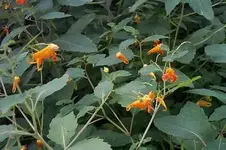Gypsy Heart
Gold Member
- #1
Thread Owner
Was reading on Jeffs case of Poison Ivy and thought it would be fun to have a Herbal Folk Remedy thread. I gather and use alot of herbs ,for different ailments and health. Some have been passed down through the generations ,and some are newer versions that I have experiented with. Would like to hear other herbal cures from TN members.
Poison Ivy
The juice from the stem of Jewelweed are used to cure poison ivy and other plant induced rashes, as well as many other types of dermatitis
Jewelweed works by counter-reacting with the chemicals in other plants that cause irritation. Poultices and salves from Jewelweed are a folk remedy for bruises, burns, cuts, eczema, insect bites, sores, sprains, warts, and ringworm.
Jewelweed blooms May through October in the eastern part of North America from Southern Canada to the northern part of Florida. It is found most often in moist woods, usually near poison ivy or stinging nettle. Jewelweed often grows on the edge of river or creek beds.
When you have been exposed to poison ivy, oak, or stinging nettle you can reach for the jewelweed plant and slice the stem, then rub its juicy inside on exposed parts. This will promptly ease irritation and usually prevents breakout for most people.
Jewelweed or an infusion made from boiling leaves of Impatiens capensis may be frozen for later use. Brew chopped jewelweed in boiling water until you get a dark orange liquid. Yellow Jewelweed will not yield orange color and may not be effective. Strain the liquid and pour into ice cube trays. Its better to then remove icecubes and place in a Ziplock baggie and label it ,returning to freezer.When you have a skin rash, rub it with a cube. It will keep in freezer up to a year.
It does not dry well due to its high moisture and oil content. Do not make alcoholic tinctures from Jewelweed because some people have had a bad reaction using jewelweed with alcohol.
Poison Ivy
The juice from the stem of Jewelweed are used to cure poison ivy and other plant induced rashes, as well as many other types of dermatitis
Jewelweed works by counter-reacting with the chemicals in other plants that cause irritation. Poultices and salves from Jewelweed are a folk remedy for bruises, burns, cuts, eczema, insect bites, sores, sprains, warts, and ringworm.
Jewelweed blooms May through October in the eastern part of North America from Southern Canada to the northern part of Florida. It is found most often in moist woods, usually near poison ivy or stinging nettle. Jewelweed often grows on the edge of river or creek beds.
When you have been exposed to poison ivy, oak, or stinging nettle you can reach for the jewelweed plant and slice the stem, then rub its juicy inside on exposed parts. This will promptly ease irritation and usually prevents breakout for most people.
Jewelweed or an infusion made from boiling leaves of Impatiens capensis may be frozen for later use. Brew chopped jewelweed in boiling water until you get a dark orange liquid. Yellow Jewelweed will not yield orange color and may not be effective. Strain the liquid and pour into ice cube trays. Its better to then remove icecubes and place in a Ziplock baggie and label it ,returning to freezer.When you have a skin rash, rub it with a cube. It will keep in freezer up to a year.
It does not dry well due to its high moisture and oil content. Do not make alcoholic tinctures from Jewelweed because some people have had a bad reaction using jewelweed with alcohol.








